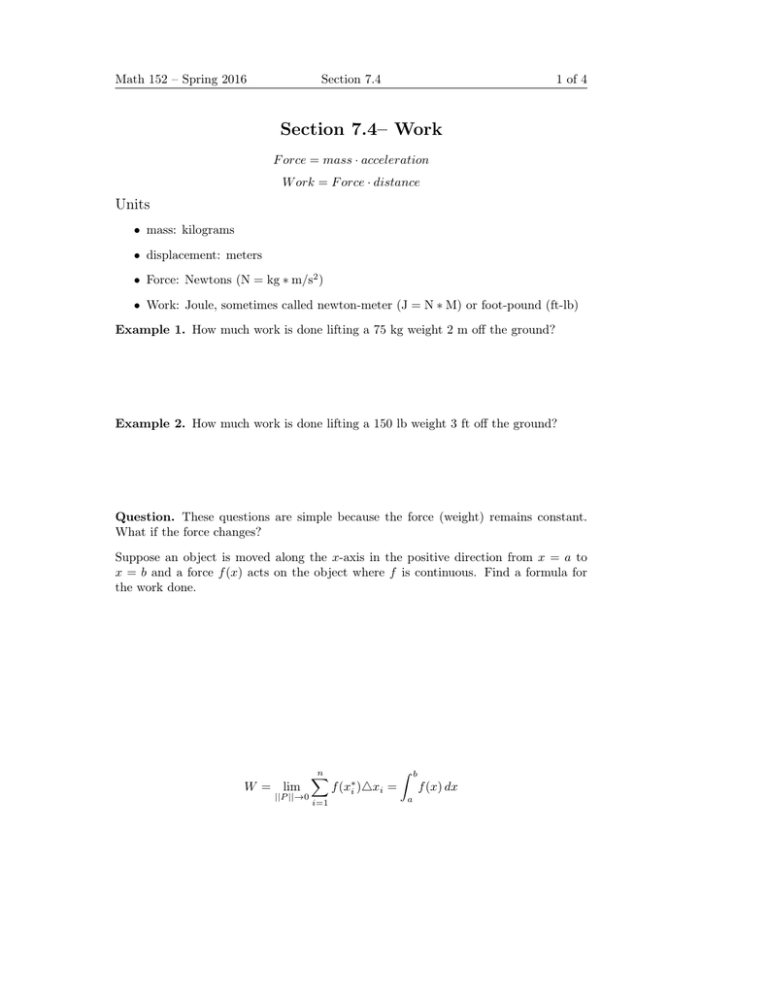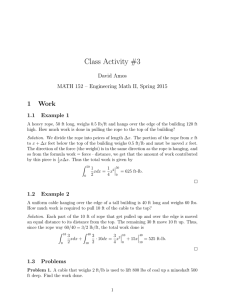Section 7.4– Work Units
advertisement

Math 152 – Spring 2016 Section 7.4 1 of 4 Section 7.4– Work F orce = mass · acceleration W ork = F orce · distance Units • mass: kilograms • displacement: meters • Force: Newtons (N = kg ∗ m/s2 ) • Work: Joule, sometimes called newton-meter (J = N ∗ M) or foot-pound (ft-lb) Example 1. How much work is done lifting a 75 kg weight 2 m off the ground? Example 2. How much work is done lifting a 150 lb weight 3 ft off the ground? Question. These questions are simple because the force (weight) remains constant. What if the force changes? Suppose an object is moved along the x-axis in the positive direction from x = a to x = b and a force f (x) acts on the object where f is continuous. Find a formula for the work done. W = lim ||P ||→0 n X i=1 f (x∗i )4xi = Z b f (x) dx a Math 152 – Spring 2016 Section 7.4 2 of 4 Example 3. When a particle is at a distance x meters from the origin, a force of cos(πx/3) acts on it. How much work is done in moving the particle from x = 12 to x = 1? Springs Theorem (Hooke’s Law). The force f (x) required to hold a spring stretched x units beyond its natural length is proportional to x, i.e., f (x) = kx where k is a positive constant (the spring constant). Remark. Notice that x is the distance beyond the springs natural length, NOT the length of the spring. Theorem. The work done stretching a spring with spring constant k from a distance a to b past its natural length (with b ≥ a ≥ 0) is equal to Z W = b kx dx a Example 4. Suppose a spring has a natural length of 5 cm, and a force of 15 N is required to hold the spring stretched to 8 cm. How much work is done stretching the spring from 11 cm to 13 cm. Example 5. Suppose the work required to stretch a spring from its natural length to 2 ft beyond its natural length is 12 ft-lb. How much work is required to stretch it 18 in. beyond its natural length? Math 152 – Spring 2016 Section 7.4 3 of 4 Ropes Example 6. Suppose a rope that weighs 10 lb and is 50 ft long is hanging off a roof. (a) How much work is required to pull the rope to the top? (b) How much work is required to pull 10 ft of the rope to the top? Example 7. A bucket that weighs 5 lb and carries 25 lbs of water is used to draw water from a well 100 ft deep. If the rope weighs .25 lb per ft, find the amount of work required to lift one bucket of water to the surface. Math 152 – Spring 2016 Section 7.4 4 of 4 Tanks of Water Example 8. A tank is full of water. Find the work required to pump the water out of the outlet. Water weighs 62 ft/lb2 or 1000 kg/m2 . (a) (Sideways cylindrical tank with radius r, length a, spout b, all in meters) Solution Method • Find the volume for a typical cross-section. • Multiply by 1000 kg/m3 ∗9.8 m/s2 or 62.5 lb/f t3 to get force for cross-section. • Work for cross-section equals force times the distance the cross-section needs to travel. • Convert to an integral and solve. (b) (Upside down pyramid with base 5 ft by 5 ft square, and height 10 ft.)





